| Noreen Debnam, Sandra McCreary, Robert Hayes, Gladys Coleman, Henry Brown, Juanita Moore discuss the growing problems black students encountered on and off campus. - 2.8MB mp3 | |
| Henry Brown, Juanita Moore and Noreen Debnam discuss the reasons for forming a Black Student Union on campus. - 568k mp3 | |
| Don Jorgenson describes the Committee for the Culturally Distinct. - 588k mp3 | |
| Don Jorgenson, Juanita Moore and Counselor Phil Layne discuss the difficult responsibility of James McKee. - 472k mp3 | |
| Juanita Moore and Geoff McCreary discuss Dick Gregory's visit. - 344k mp3 | |
| Noreen Debnam, Robert Hayes, Sandra McCreary, Don Jorgenson, and Herb Gaede discuss the problems with Þnancial aid. - 596k mp3 | |
| Gladys Coleman, Juanita Moore, Sandy McCreary, and Robert HGladys Coleman, Juanita Moore, Sandy McCreary, and Robert Hayes relate their memories of the November 20 meeting of African American students at the campus Newman Center. - 824k mp3 |
Please click a thumbnail for more detail.
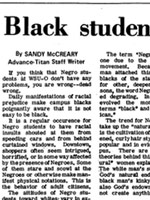
Sandy McCreary wrote for the campus newspaper, the Advance-Titan. In this article, published just weeks before the Black Thursday demonstrations, she addressed the escalating racial tensions on campus.
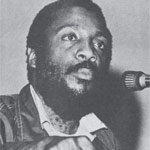
In October, comedian-turned-activist-turned-presidential candidate Dick Gregory delivered a two-hour speech on “Civil Rights and Black Power.” Gregory explained to the white and black students who segregated themselves in the bleachers that in 1968 African Americans were simply saying what Patrick Henry declared two centuries earlier: “Give me liberty or give me death.”
Photos of Dick Gregory speech from The Quiver.
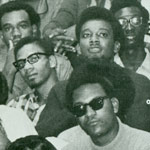
African American students at WSU-Oshkosh listened attentively to Gregory's speech from the auditorium's bleachers.
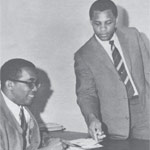
James McKee (seated) was assisted by one of WSU-O’s first black graduates, Phil Layne. When McKee arrived in Oshkosh in September, he had little preparation for the challenges he would soon face.
Photo by The Quiver.
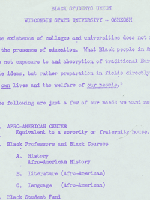
The Black Student Union, representing a significant portion of the African American student population, issued this
"non-negotiable" set of demands to the WSU-Oshkosh administration in October, 1968.
In addition to experiencing the normal challenges of college adjustment, African American freshman students at WSU-O encountered numerous problems stemming from the unfavorable racial climate of Northeast Wisconsin. Indeed, as the numbers of African American students grew, so did instances of unfavorable treatment from professors and coaches. Responding to mounting concerns over housing discrimination in Oshkosh, the harassment of black students in campus dormitories, and fair grading policies, as well as the shared desire to press the campus administration for courses in African American history and literature, several dozen black WSU-O students organized the first Black Student Union (BSU) in the state of Wisconsin in February 1968.
The complaints catalogued by Milwaukee sophomore Russell Brown and New York freshman Michael Gordon, early spokesmen for the BSU, found sympathy within a segment of the faculty and with the Oshkosh Human Rights Council in particular. But more than a few white students and local residents were put off by the idea of a BSU.
Hostility from students and townspeople, while relatively muted when the numbers of African American students on campus was small, increased markedly by the fall of 1968. Black students who returned to WSU-O in the fall 1968 semester could not help notice a new uneasiness permeating the campus and community. With the addition of nearly fifty new black freshmen, the African American presence was now inescapable. Racial tensions inevitably intensified. The epithet “nigger” was regularly hurled at black students from fraternities and dorm windows. African American students were taunted and on at least one occasion pelted with rocks by Oshkosh teenagers. Since members of the younger cohort experienced or participated in the Milwaukee high school disruptions of the previous spring, they were less reticent to speak out and more prone to strike back. Violent encounters were reported at area beer bars and in the basement of Scott Hall. One student, a co-chair of the campus right-wing Young Americans for Freedom organization described the campus as being in a “state of turmoil” and therefore pledged to form a “white protection society.”
When incoming students discovered that the financial aid that had been promised to them was in practice difficult to receive, when, due to a shortage of dormitory space, some new black female students were forced to inhabit subdivided spaces within floor lounges, they began to suspect that the WSU-O administration cared little about their concerns. On October 15, members of the BSU presented administration staff with a list of requests. In addition to calling for courses in history and literature that were relevant to the African American experience, the BSU pushed for the hiring of black faculty and, perhaps most importantly, the creation of a new African American cultural center—a place where black students could congregate and enjoy the distinctive elements of their shared experience as African Americans.
Unfamiliar with the time it takes for new ideas to slog through the university’s maze of bureaucracy, BSU members grew impatient. They began to suspect that their concerns and demands were not reaching the one person on campus who had the authority to act on them immediately, President Roger Guiles. On the night of November 20, members of the BSU convened at the campus Newman Center and resolved to do something to make their voices heard. After much debate about the BSU’s future course of action, the students made a fateful decision: early the next morning they would assemble as a group, march over to executive administrative offices in Dempsey Hall and confront President Guiles in person.
